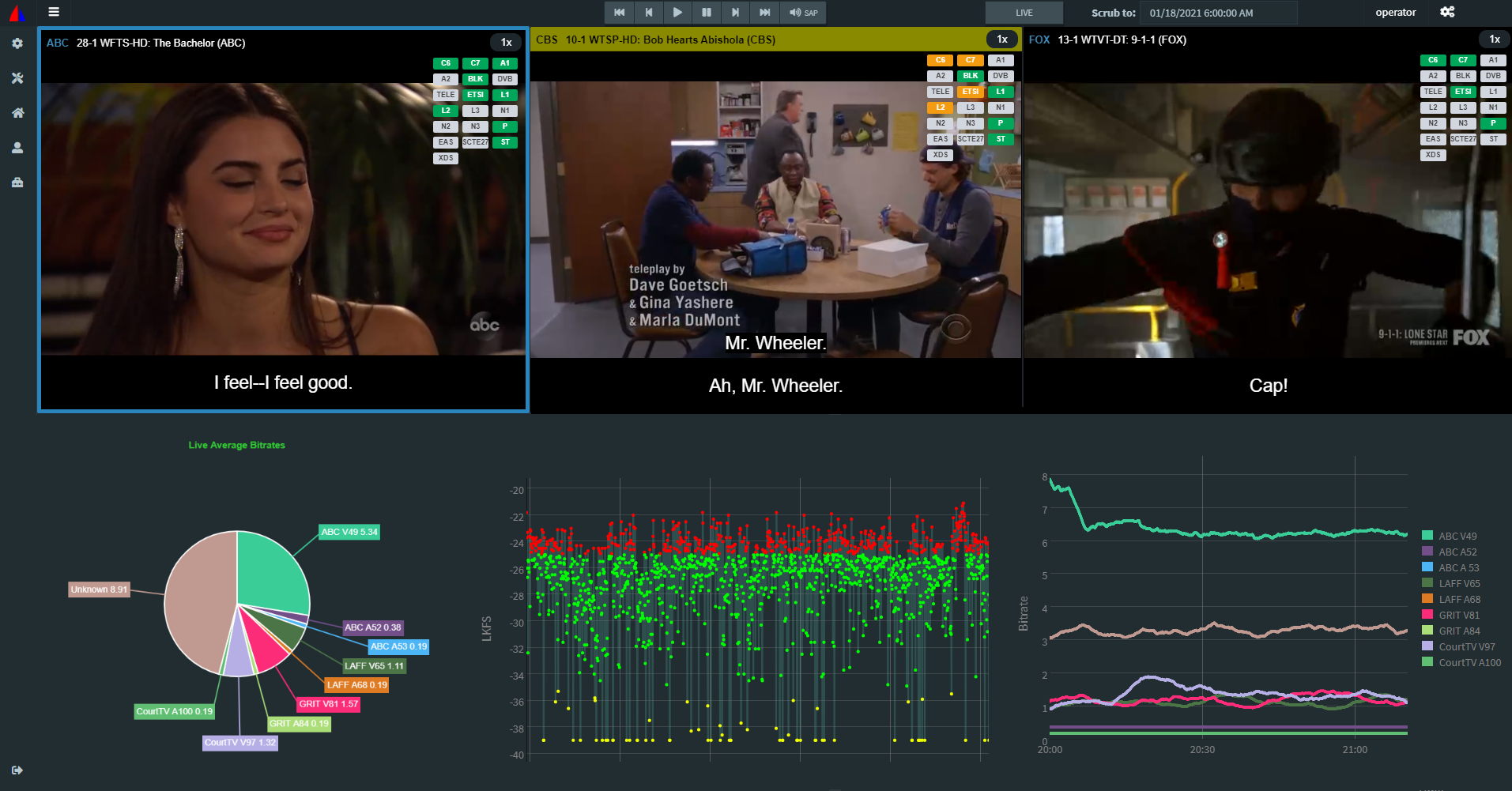
Compliance Monitoring Shifts Into Swiss Army Knife Mode

Evolving monitoring and compliance tools are now handling new broadcast formats while also offering features intended to ease workflows.
The dust has mostly settled from compliance giant Volicon shuttering several years ago. New protocols and formats — not to mention a growing number of channels — need to monitored, and vendors are working to provide those solutions. At the same time, more broadcasters want to use a hybrid cloud environment, which presents challenges of its own.
But uses for monitoring and compliance tools extend beyond making sure content meets regulatory requirements. Nowadays, monitoring and compliance tools are more like Swiss Army knives in their new features and use cases and the ways they aim to make lives easier for broadcasters.
Ric Belding, Vela’s senior director of sales engineering, says the compliance and monitoring segment is past the wave of former Volicon customers rushing out to find a replacement solution and is now seeking new customers.
“Why they’re looking has changed,” Belding says. “We’re no longer looking at the Volicon bubble.”
Mediaproxy CEO Erik Otto says companies are focused on carefully choosing a compliance and monitoring product to invest in because the decision can lock them into a particular technology for a number of years.
“They’re not just buying a thing off the shelf anymore,” Otto says. “You make a far more significant commitment when you pick a technology.”

Mediaproxy’s LogPlayer shows digital picture insertion, such as showing when different commercials were inserted for different regions.
Whichever compliance and monitoring tool a broadcaster chooses, it must be capable of dealing with new protocols and formats, such as SRT for secure transmission and ATSC 3.0, in addition to an increased number of channels to be monitored.
“New protocols are very important to our industry, and compliance companies need to be able to keep up with that, not just logging, but putting it up in multiviewers and handling extra data associated with these streams,” Belding says.
Ken Rubin, Actus Digital’s SVP for Americas, notes it’s been voluntary for markets to distribute ATSC 3.0 channels, but those that are distributed must be compliant. As such, he says, compliance tools need to be able to handle that demand.
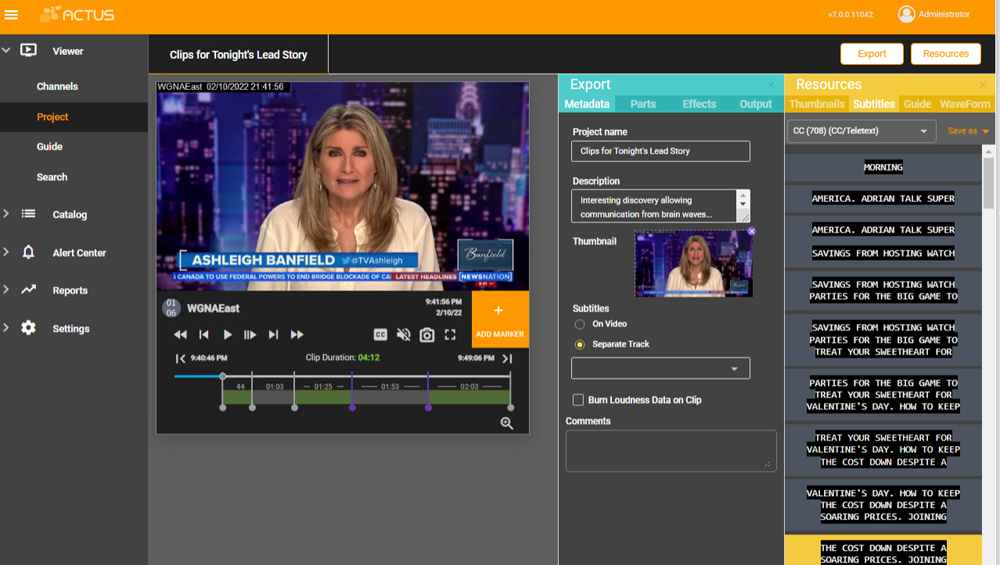
The Actus system shown here is being used by Nexstar’s News Nation in Chicago and New York to preview and source content.
Ralph Bachofen, Triveni Digital’s VP of sales and marketing, says his company is helping its customer base migrate from ATSC 1.0 to ATSC 3.0. “They have to look at 1.0 and 3.0 and analyze both,” he says. “We are able to compare the two products to each other to make sure quality is where it needs to be for their internal environment.”
And more 4K content is going to air.
For something that is shot in 4K Dolby Vision with Atmos, “you have to deal with a massive resolution image and you have to process the color space and extra audio, and we have to do all of this in the cloud,” Otto says. “It’s as challenging as it gets in terms of where the innovation and engineering goes.”
Anupama Anantharaman, VP of product management at Interra Systems, says OTT video has widened the monitoring scope to include new formats and standards, closed captions and subtitling, ad insertions and content classification.
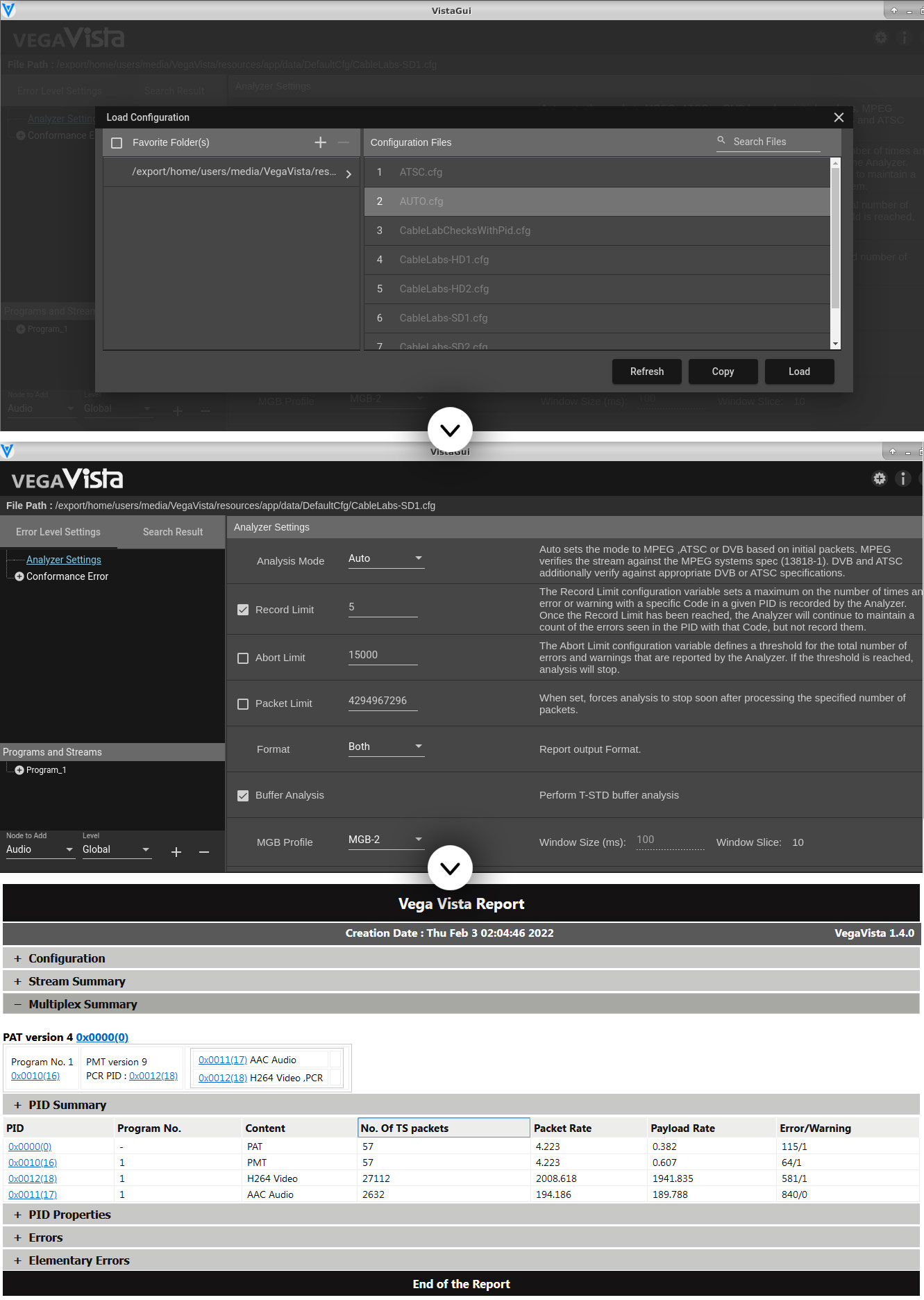
Interra Systems’ VEGA Vista verifies MPEG-2 transport streams against the MPEG standard and is used at various points in the workflow to check compressed video for quality, compliance and interoperability.
“We are seeing an increased need for these tools to work in the cloud, perform at scale and provide a more efficient path for global media delivery,” she says.
Russell Wise, SVP of sales and marketing at Digital Nirvana, says a lot about compliance logging has changed since the early 2000s, but a lot has stayed the same.
“Features have evolved, scalability has evolved and the number of channels that can be monitored has greatly increased,” he says.
Otto says: “Compliance never operated at scale. Now it has to operate at scale.”
Qligent CEO Brick Eksten says one of the bigger challenges of newer projects is the move to a hybrid cloud model as broadcasters consolidate operations and plan for a “future where everything is remote.”
And one of the first things a hybrid model affects, he says, is monitoring shared broadcast streams.
Moving some or all of a broadcaster’s playout into the cloud “means internal or external handoff points that are new and typically unmanaged. They not only have more points to monitor, but they have more points where more things can go wrong,” Eksten says.
As such, he says, broadcasters need to monitor what they are pushing out not just over the airwaves or OTT, but those shared streams as well.
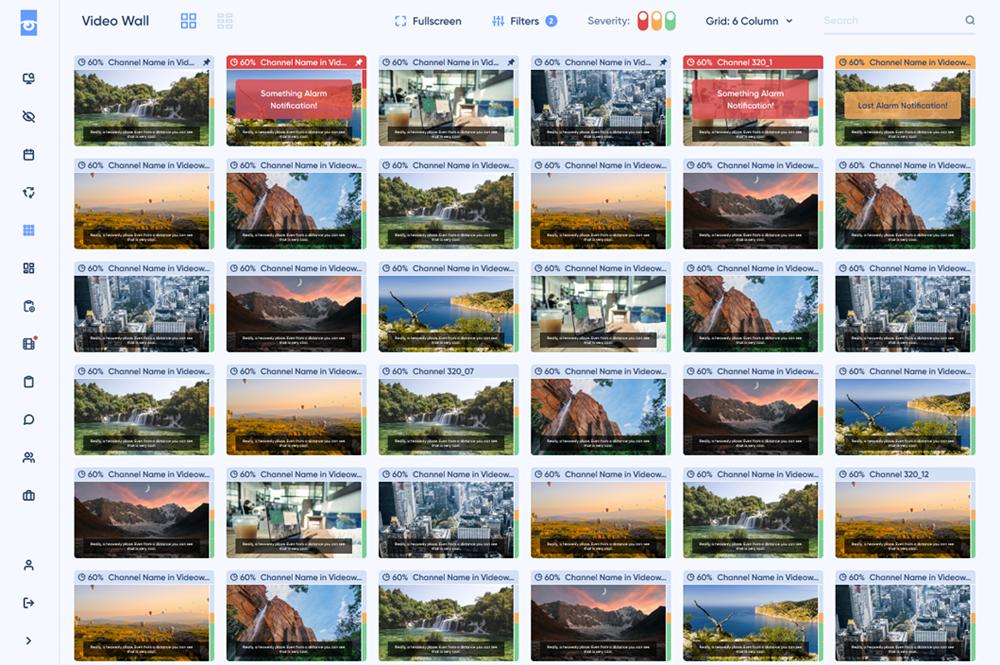
The video wall in Qligent’s Vision 5 product can automatically sort channels by user-defined quality of service or quality of experience priority.
And as customers need a hybrid or multifacility monitoring solution, Qligent also saw the need for unified monitoring, or a “single source of truth to look at the entirety of your supply chain,” he says.
Over the last 18 months, Qligent rewrote its entire software set “with an eye toward what we believe the future is going to look like,” Eksten says. That future is more highly automated and needs to monitor the entirety of the supply chain.
Qligent has deployed the revised software live with customers, primarily in telco, but is actively engaged in pilot projects with North American customers, he says.
Customers have begun viewing monitoring and compliance “as a Swiss Army knife, a tool they can use anywhere in the organization. They are exploring how to use it,” Wise says. “Engineers use it to look at transmission of video and collect analytics on that, ad people see that their ads ran and cut clips of the ad. They look at how great the ad looked, so it can be a marketing tool for ad sales. People in the news organization use it to cut clips to repurpose content for rebroadcast.”
Wise says one of the main things he’s seeing evolve is how customers are using compliance and monitoring tools in the broadcast environment. One of Digital Nirvana’s video distributor clients uses the system to record ads as a way of proving they were delivered to the targeted zones, he says.
“We’re seeing a lot of that,” he says.
Another area of focus is searchability, which can play a role in compliance.
“We have a suite of AI tools that help with searching,” Wise says.

Triveni Digital’s New StreamScope XM ATSC 3.0 monitor includes professional monitoring, auditing and logging capabilities.
Machine learning will continue to be important in compliance monitoring, Anantharaman says.
“Content volumes are increasing. There is no way video service providers can have human resources thrown at the content validation process. It’s inefficient and expensive. In the next few years, we will see more machine learning-based tools that solve specific problems,” she says.
One of those is ensuring OTT content follows local rules, such as for classifications, in each country, she says.
“Classifications based on violent content, adult content, object and facial recognition,” she says. “For all these things you need to have very efficient automated tools so content classification becomes very easy.”
During NAB, Triveni will launch its StreamScope XM Monitor, which builds on the analyzer the company has been deploying for the last couple of years, Bachofen says. The monitor is intended to help troubleshoot problems, log information and do customer reports.
One of the features Actus will talk about during NAB is its Synchro and its OTT Synchro feature, which makes it possible to organize a channel list display on a multiviewer and makes it possible to look at multiple probe points in the delivery workflow, Rubin says. It’s in beta testing with customers now.
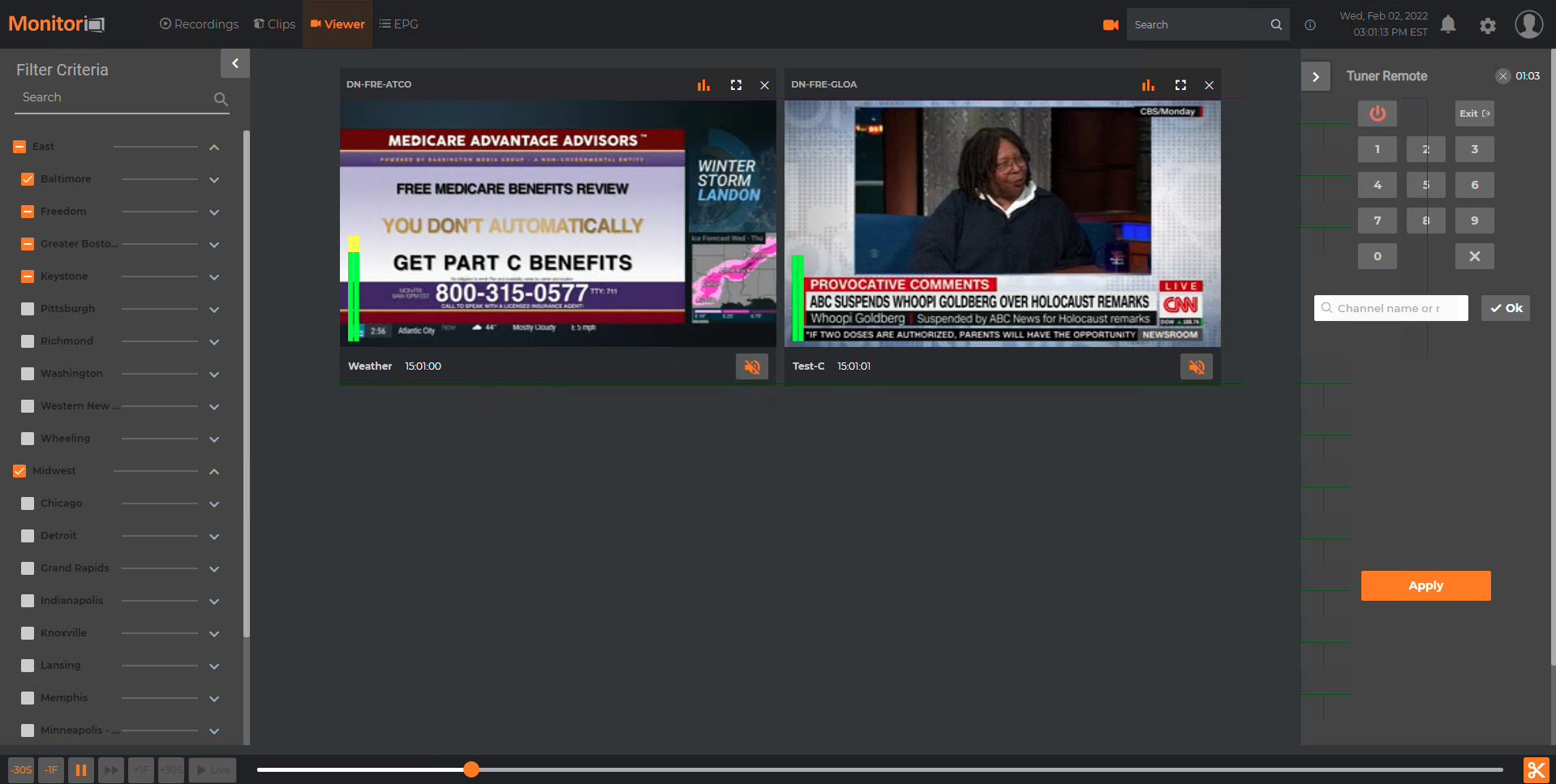
Digital Nirvana’s viewer shows ad zones.
One of the most popular use cases of Actus’ monitoring and compliance tool has been content repurposing, or clipping, he says. Nexstar stations in Chicago and New York use this for clipping, Rubin says.
Actus’ monitoring system also offers an ad-match feature for tracking commercials, which offers daily intelligence on ad spots, rather than having to wait for Nielson reports to arrive, Rubin says.
With OTT, Belding says, there is the capability to target commercials for content viewed in different locales. Compliance tools like Vela’s Encompass smart logger can show the quality was right in all locations and that the commercials that ran were the ones targeted for those locations, he says.
“Compliance must provide ways to record and log multiple streams,” he says. “Compliance, monitoring and multiviewer companies need to be able to accommodate this different landscape.”
Compliance and monitoring tools have evolved to offer a host of features that help broadcasters ensure they meet regulatory mandates, but they have become much more than that, Belding says, adding: “They also make the lives and tasks of customers so much easier.”
































Comments (0)